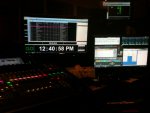Re: NOOB!
Thanks Tim! I have watched a bunch of the vids and read hundreds (literally, including the quick start manual) of pages, and thought I had a good general understanding, but when I got the XControl to play with it, I kinda got overwhelmed. I've just got to figure out how it makes sense to me. I figure I'll be running vocals , keys, guitars on level 1, drums and everything else on level 2. They will go to aux levels for drums , guitars, vox, etc., then mons on the next level aux subs. just not sure how to insert effects on the channel or assign to the sub. probably the guy who sets the system up will have it sorted out and I can tweak it from there if need be.. I don't understand DCAs at all... I think I have a hint, but I'm not sure.... hopefully y'all won't have to babysit me long...lol
Nick,I too am a newcomer both to this board and to digital mixing; having only every run analogue consoles. (I guess with the exception of digital 'in-the-box' mixing and routing in Pro Tools).
I have found this forum and this thread in particular very informative for picking up the tricks and tips for running digital boards.
Think of a DCA as an assignable remote control for various inputs; it is not an audio path.
If you assign, say, all your drum kit mics to DCA1, then moving DCA1 fader up or down would be the equivalent of grabbing all 7 or 8 faders and moving them up and down at the same time, keeping their relative ratios between each other the same.
The audio isn't summed at the DCA so you can't apply any processing to it or EQ it as a group. It's just an assignable remote control for the faders that are assigned to it.
This differs from a sub group, which is an audio path and the audio signals that you assign to it are summed at the group master. This allows you to assign, say, all your drum kit inputs, or the whole kit except kick and snare, and then apply some compression or EQ to that whole group of inputs. For this to work, you take the signal from those channels out of the main LR bus, assign them to say, sub group 1, then put sub group 1's output into the main LR bus.This means no signal goes directly from your eg. rack tom mic out to the LR, it goes from you channel fader, through the group fader, then into the main LR.
This lets you group up all your instruments and apply some group based compression to each, while maybe relaxing the compression on the vocals for eg. This will help keep the vocals on top of the mix.
Dave Rat (search on youtube) has a great video explaining this technique.
The 16 busses on the x32 are configurable between pre-fade outs (for your foldback sends if mixing monitors from FOH), sub groups (for routing your inputs into groups for group-based processing) and post-fade outs (for sending to effects).
The 8 DCAs are seperate to this.
I think where you say "They will go to aux levels for drums , guitars, vox, etc" you mean sub groups, and " then mons on the next level aux subs" you mean pre-fade sends.If you don't want to apply group based processing, you could skip using the sub groups and just mix with the DCAs.
Hope that helps. . I'm still learning it all myself!
Cheers,Ryan
 ~:-D~:grin:
~:-D~:grin:


